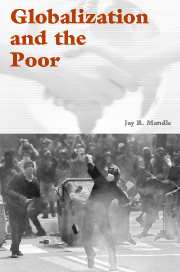Book contents
- Frontmatter
- Contents
- Preface
- 1 Introduction
- 2 Economic Globalization and the Development of Poor Nations
- 3 The Sources of Opposition
- 4 Alternatives to Globalization
- 5 The Anti-Globalization Movement and the Multilateral Agreement on Investment
- 6 Regulating International Financial Markets
- 7 The Student Anti-Sweatshop Movement
- 8 Saving Globalization
- References
- Index
8 - Saving Globalization
Published online by Cambridge University Press: 05 June 2012
- Frontmatter
- Contents
- Preface
- 1 Introduction
- 2 Economic Globalization and the Development of Poor Nations
- 3 The Sources of Opposition
- 4 Alternatives to Globalization
- 5 The Anti-Globalization Movement and the Multilateral Agreement on Investment
- 6 Regulating International Financial Markets
- 7 The Student Anti-Sweatshop Movement
- 8 Saving Globalization
- References
- Index
Summary
The United States, far more than any other country, has had a decisive voice in determining the content of the policies and procedures that have accompanied globalization. Its voice has been and still is dominant in multilateral organizations such as the World Bank and the IMF, and it was the most powerful influence in shaping the content of the rules that the WTO enforces (Mandle 2001).
In all of this, the position of the United States has been remarkably consistent over the years. The transition from Republican administrations in the 1980s to Democratic ones in the 1990s resulted in no change in fundamentals and the same is likely to be true of the administration of George W. Bush. The economist John Williamson is given credit for first labeling as “the Washington Consensus” the package of policies endorsed by the United States. With the Washington Consensus, the United States exercised pressure on other nations to emphasize markets and diminish the role of the public sector. As Williamson formulated it, the Washington Consensus included ten elements (Williamson 1999, 2):
Fiscal discipline in government spending.
A redirection of public expenditures away from subsidies and toward education, health, and infrastructure.
A reduction of marginal tax rates.
Decontrol of interest rates.
Movement away from fixed exchange rates to more market determined ones.
Trade liberalization.
Liberalization of foreign direct investment inflows.
Privatization of public enterprises.
[…]
- Type
- Chapter
- Information
- Globalization and the Poor , pp. 121 - 132Publisher: Cambridge University PressPrint publication year: 2003

